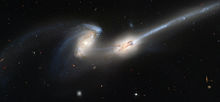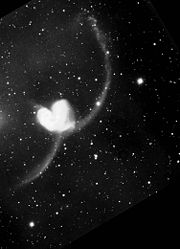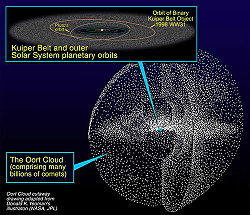
Galactic tide
Encyclopedia

Tidal force
The tidal force is a secondary effect of the force of gravity and is responsible for the tides. It arises because the gravitational force per unit mass exerted on one body by a second body is not constant across its diameter, the side nearest to the second being more attracted by it than the side...
experienced by objects subject to the gravitational field
Gravitational field
The gravitational field is a model used in physics to explain the existence of gravity. In its original concept, gravity was a force between point masses...
of a galaxy
Galaxy
A galaxy is a massive, gravitationally bound system that consists of stars and stellar remnants, an interstellar medium of gas and dust, and an important but poorly understood component tentatively dubbed dark matter. The word galaxy is derived from the Greek galaxias , literally "milky", a...
such as the Milky Way
Milky Way
The Milky Way is the galaxy that contains the Solar System. This name derives from its appearance as a dim un-resolved "milky" glowing band arching across the night sky...
. Particular areas of interest concerning galactic tides include galactic collisions
Interacting galaxy
Interacting galaxies are galaxies whose gravitational fields result in a disturbance of one another. An example of a minor interaction is a satellite galaxy's disturbing the primary galaxy's spiral arms. An example of a major interaction is a galactic collision.-Satellite interaction:A giant...
, the disruption of dwarf
Dwarf galaxy
A dwarf galaxy is a small galaxy composed of up to several billion stars, a small number compared to our own Milky Way's 200-400 billion stars...
or satellite galaxies
Satellite galaxy
A satellite galaxy orbits a larger galaxy due to gravitational attraction. Although a galaxy is made of a large number of objects which are not connected to each other, it has a center of mass, which represents a weighted average of the positions of each component object...
, and the Milky Way's tidal effect on the hypothesized Oort Cloud
Oort cloud
The Oort cloud , or the Öpik–Oort cloud , is a hypothesized spherical cloud of comets which may lie roughly 50,000 AU, or nearly a light-year, from the Sun. This places the cloud at nearly a quarter of the distance to Proxima Centauri, the nearest star to the Sun...
of our own solar system
Solar System
The Solar System consists of the Sun and the astronomical objects gravitationally bound in orbit around it, all of which formed from the collapse of a giant molecular cloud approximately 4.6 billion years ago. The vast majority of the system's mass is in the Sun...
.
Origin
.png)
.png)
Gravitational field
The gravitational field is a model used in physics to explain the existence of gravity. In its original concept, gravity was a force between point masses...
of a large mass (the yellow object), it becomes tidally distorted.
Gravitational attraction increases with decreasing distance; the closer any object A is to another object B, the more intensely A is affected by the object B's gravity, according to Newton's law of universal gravitation
Newton's law of universal gravitation
Newton's law of universal gravitation states that every point mass in the universe attracts every other point mass with a force that is directly proportional to the product of their masses and inversely proportional to the square of the distance between them...
. This is also true of the different parts of an object; The surface of object A feels a stronger attraction to object B than the core of object A. When the other object's gravity is particularly strong, this causes the smaller object's surface to pull away from the core, and the object to distend and flatten in the direction of the larger object. The large body feels a similar but far weaker distortion caused in the same way by the gravitational field of the small body. In technical terms, the equilibrium
Mechanical equilibrium
A standard definition of static equilibrium is:This is a strict definition, and often the term "static equilibrium" is used in a more relaxed manner interchangeably with "mechanical equilibrium", as defined next....
shape of the small body is the one that minimizes its gravitational potential energy
Potential energy
In physics, potential energy is the energy stored in a body or in a system due to its position in a force field or due to its configuration. The SI unit of measure for energy and work is the Joule...
. In empty space, this would be a sphere. However, in the proximity of the large body, the lowest potential energy shape is an ovoid stretched along the axis connecting the two bodies.
For example, the tides on Earth are caused by the distortion that the Moon
Moon
The Moon is Earth's only known natural satellite,There are a number of near-Earth asteroids including 3753 Cruithne that are co-orbital with Earth: their orbits bring them close to Earth for periods of time but then alter in the long term . These are quasi-satellites and not true moons. For more...
and the Sun
Sun
The Sun is the star at the center of the Solar System. It is almost perfectly spherical and consists of hot plasma interwoven with magnetic fields...
cause to the Earth's gravitational field. In this case, the Earth's rotation is slow enough that the Earth is able to reshape itself so that the distortions remain oriented approximately in the direction of the Moon and the Sun. From the point of view of a person on the surface, we pass over the long axes of the distortions approximately twice a day for each, at which points high tide are experienced. Since the relative positions of the Earth, Sun and Moon are constantly changing, the tidal effects reinforce or counteract each other to various degrees. (see Spring tide and Neap tide).
Galactic tides demonstrate the same processes on a far grander scale. Tidally interacting galaxies will be stretched towards each other. They may eventually flatten out and distend towards the galaxy's centre, or suffer perturbations to their orbits. Furthermore, if the galaxies are rapidly rotating, their sections may not be able to keep up with the distortion like the Earth, and long tails of stars and other highly distorted regions can be formed, as seen in the diagrams in this article.
Galaxy collisions

Two interacting galaxies will not always collide head-on (if at all), and the tidal forces will distort each galaxy along an axis pointing roughly towards and away from its perturber. As the two galaxies briefly orbit each other, these distorted regions, pulled away from the main body of each galaxy, will be sheared by the galaxy's differential rotation
Differential rotation
Differential rotation is seen when different parts of a rotating object move with different angular velocities at different latitudes and/or depths of the body and/or in time. This indicates that the object is not solid. In fluid objects, such as accretion disks, this leads to shearing...
and flung off into intergalactic space, forming tidal tails. Such tails are typically strongly curved; where a tail appears straight, it is probably being viewed edge-on. The stars and gas that comprise the tails will have been pulled from the easily distorted galactic discs (or other extremities) of one or both bodies, rather than the gravitationally bound galactic centres. Two very prominent examples of collisions producing tidal tails are the Mice Galaxies
Mice Galaxies
NGC 4676, or the Mice Galaxies, are two spiral galaxies in the constellation Coma Berenices. About 290 million light-years away, they are presently in the process of colliding and merging...
and the Antennae Galaxies
Antennae Galaxies
The Antennae Galaxies are a pair of interacting galaxies in the constellation Corvus. They are currently going through a phase of starburst. They were discovered by William Herschel in 1785...
.
Just as the Moon raises two water tides on opposite sides of the Earth, so a galactic tide produces two arms in its galactic companion. While a large tail is formed if the perturbed galaxy is equal to or less massive than its partner, if it is significantly more massive than the perturbing galaxy, then the trailing arm will be relatively minor, and the leading arm, sometimes called a bridge, will be more prominent. Tidal bridges are typically harder to distinguish than tidal tails: in the first instance, the bridge may be absorbed by the passing galaxy or the resulting merged galaxy, making it visible for a shorter duration than a typical large tail. Secondly, if one of the two galaxies is in the foreground, then the second galaxy — and the bridge between them — may be partially obscured. Together, these effects can make it hard to see where one galaxy ends and the next begins. Tidal loops, where a tail joins with its parent galaxy at both ends, are rarer still.
Satellite interactions
Because tidal effects are strongest in the immediate vicinity of a galaxy, satellite galaxies are particularly likely to be affected. Such an external force upon a satellite can produce ordered motions within it, leading to large-scale observable effects: the interior structure and motions of a dwarf satellite galaxy may be severely affected by a galactic tide, inducing rotation (as with the tides of the Earth's oceans) or an anomalous mass-to-luminosity ratio. Satellite galaxies can also be subjected to the same tidal stripping that occurs in galactic collisions, where stars and gas are torn from the extremities of a galaxy, possibly to be absorbed by its companion. The dwarf galaxy M32Messier 32
Messier 32 is a dwarf elliptical galaxy about 2.65 million light-years away in the constellation Andromeda. M32 is a satellite galaxy of the famous Andromeda Galaxy and was discovered by Le Gentil in 1749. M32 measures only 6.5 ± 0.2 kly in diameter at the widest point...
, a satellite galaxy of Andromeda
Andromeda Galaxy
The Andromeda Galaxy is a spiral galaxy approximately 2.5 million light-years from Earth in the constellation Andromeda. It is also known as Messier 31, M31, or NGC 224, and is often referred to as the Great Andromeda Nebula in older texts. Andromeda is the nearest spiral galaxy to the...
, may have lost its spiral arms to tidal stripping, while a high star formation rate in the remaining core may be the result of tidally-induced motions of the remaining molecular cloud
Molecular cloud
A molecular cloud, sometimes called a stellar nursery if star formation is occurring within, is a type of interstellar cloud whose density and size permits the formation of molecules, most commonly molecular hydrogen ....
s (Because tidal forces can knead and compress the interstellar gas clouds inside galaxies, they induce large amounts of star formation
Star formation
Star formation is the process by which dense parts of molecular clouds collapse into a ball of plasma to form a star. As a branch of astronomy star formation includes the study of the interstellar medium and giant molecular clouds as precursors to the star formation process and the study of young...
in small satellites. The process is somewhat similar to making something hotter by squeezing it).
The stripping mechanism is the same as between two comparable galaxies, although its comparatively weak gravitational field ensures that only the satellite, not the host galaxy, is affected. If the satellite is very small compared to the host, the tidal debris tails produced are likely to be symmetric, and follow a very similar orbit, effectively tracing the satellite's path. However, if the satellite is reasonably large—typically over one ten thousandth the mass of its host—then the satellite's own gravity may affect the tails, breaking the symmetry and accelerating the tails in different directions. The resulting structure is dependent on both the mass and orbit of the satellite, and the mass and structure of the conjectured galactic halo
Dark matter halo
A dark matter halo is a hypothetical component of a galaxy, which extends beyond the edge of the visible galaxy and dominates the total mass. Since they consist of dark matter, halos cannot be observed directly, but their existence is inferred through their effects on the motions of stars and gas...
around the host, and may provide a means of probing the dark matter
Dark matter
In astronomy and cosmology, dark matter is matter that neither emits nor scatters light or other electromagnetic radiation, and so cannot be directly detected via optical or radio astronomy...
potential of a galaxy such as the Milky Way.
Over many orbits of its parent galaxy, or if the orbit passes too close to it, a dwarf satellite may eventually be completely disrupted, to form a tidal stream of stars and gas wrapping around the larger body. It has been suggested that the extended discs of gas and stars around some galaxies, such as Andromeda, may be the result of the complete tidal disruption (and subsequent merger with the parent galaxy) of a dwarf satellite galaxy.
Effects on bodies within a galaxy
Tidal effects are also present within a galaxy, where their gradients are likely to be steepest. This can have consequences for the formation of starStar
A star is a massive, luminous sphere of plasma held together by gravity. At the end of its lifetime, a star can also contain a proportion of degenerate matter. The nearest star to Earth is the Sun, which is the source of most of the energy on Earth...
s and planetary system
Planetary system
A planetary system consists of the various non-stellar objects orbiting a star such as planets, dwarf planets , asteroids, meteoroids, comets, and cosmic dust...
s. Typically a star's gravity will dominate within its own system, with only the passage of other stars substantially affecting dynamics. However, at the outer reaches of the system, the star's gravity is weak and galactic tides may be significant. In our own solar system, the hypothetical Oort cloud
Oort cloud
The Oort cloud , or the Öpik–Oort cloud , is a hypothesized spherical cloud of comets which may lie roughly 50,000 AU, or nearly a light-year, from the Sun. This places the cloud at nearly a quarter of the distance to Proxima Centauri, the nearest star to the Sun...
, believed to be the source of long-period comet
Comet
A comet is an icy small Solar System body that, when close enough to the Sun, displays a visible coma and sometimes also a tail. These phenomena are both due to the effects of solar radiation and the solar wind upon the nucleus of the comet...
s, lies in this transitional region.

Light-year
A light-year, also light year or lightyear is a unit of length, equal to just under 10 trillion kilometres...
in radius. Across such a vast distance, the gradient of the Milky Way's gravitational field plays a far more noticeable role. Because of this gradient, galactic tides may then deform an otherwise spherical Oort cloud, stretching the cloud in the direction of the galactic centre and compressing it along the other two axes, just as the Earth distends in response to the gravity of the Moon.
The Sun's gravity is sufficiently weak at such a distance that these small galactic perturbations may be enough to dislodge some planetesimals from such distant orbits, sending them towards the Sun and planets by significantly reducing their perihelion. Such a body, being composed of a rock and ice mixture, would become a comet when subjected to the increased solar radiation present in the inner solar system.
It has been suggested that the galactic tide may also contribute to the formation of an Oort cloud, by increasing the perihelion of planetesimals with large aphelion. This shows that the effects of the galactic tide are quite complex, and depend heavily on the behaviour of individual objects within a planetary system. Cumulatively the effect can be quite significant, however; up to 90% of all comets originating from an Oort cloud may be the result of the galactic tide.
See also
- Oort cloudOort cloudThe Oort cloud , or the Öpik–Oort cloud , is a hypothesized spherical cloud of comets which may lie roughly 50,000 AU, or nearly a light-year, from the Sun. This places the cloud at nearly a quarter of the distance to Proxima Centauri, the nearest star to the Sun...
- Roche limitRoche limitThe Roche limit , sometimes referred to as the Roche radius, is the distance within which a celestial body, held together only by its own gravity, will disintegrate due to a second celestial body's tidal forces exceeding the first body's gravitational self-attraction...
- Satellite galaxySatellite galaxyA satellite galaxy orbits a larger galaxy due to gravitational attraction. Although a galaxy is made of a large number of objects which are not connected to each other, it has a center of mass, which represents a weighted average of the positions of each component object...
- Dwarf galaxyDwarf galaxyA dwarf galaxy is a small galaxy composed of up to several billion stars, a small number compared to our own Milky Way's 200-400 billion stars...
- Interacting galaxyInteracting galaxyInteracting galaxies are galaxies whose gravitational fields result in a disturbance of one another. An example of a minor interaction is a satellite galaxy's disturbing the primary galaxy's spiral arms. An example of a major interaction is a galactic collision.-Satellite interaction:A giant...
- Tidal forceTidal forceThe tidal force is a secondary effect of the force of gravity and is responsible for the tides. It arises because the gravitational force per unit mass exerted on one body by a second body is not constant across its diameter, the side nearest to the second being more attracted by it than the side...

